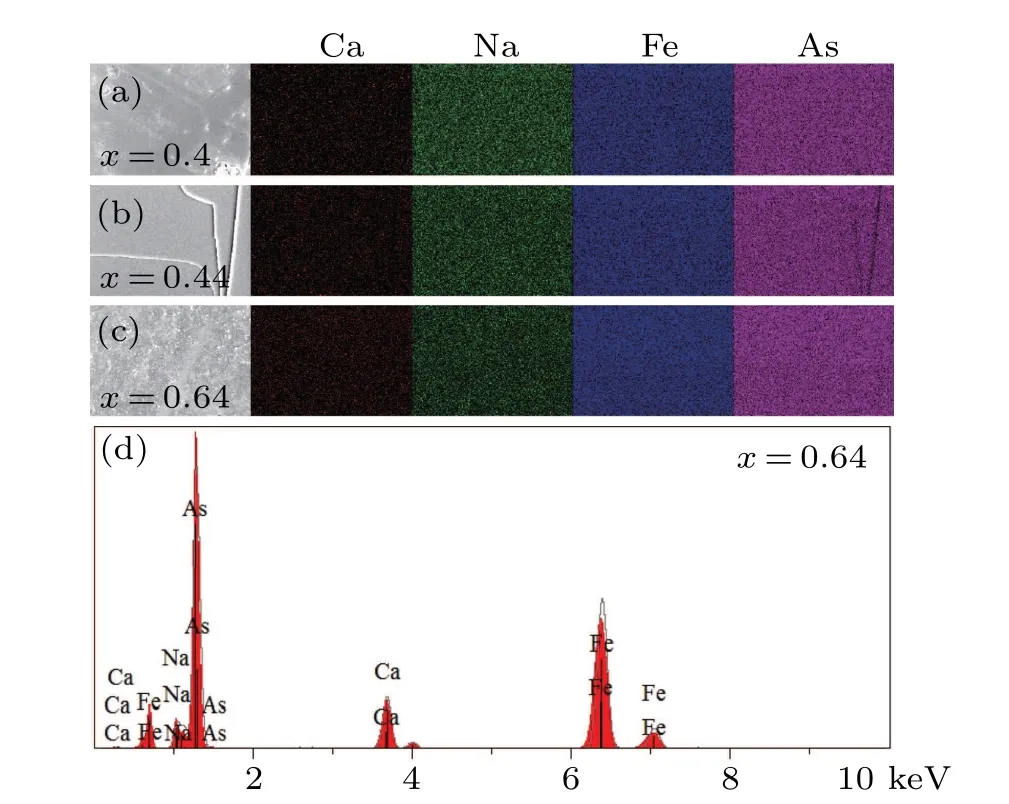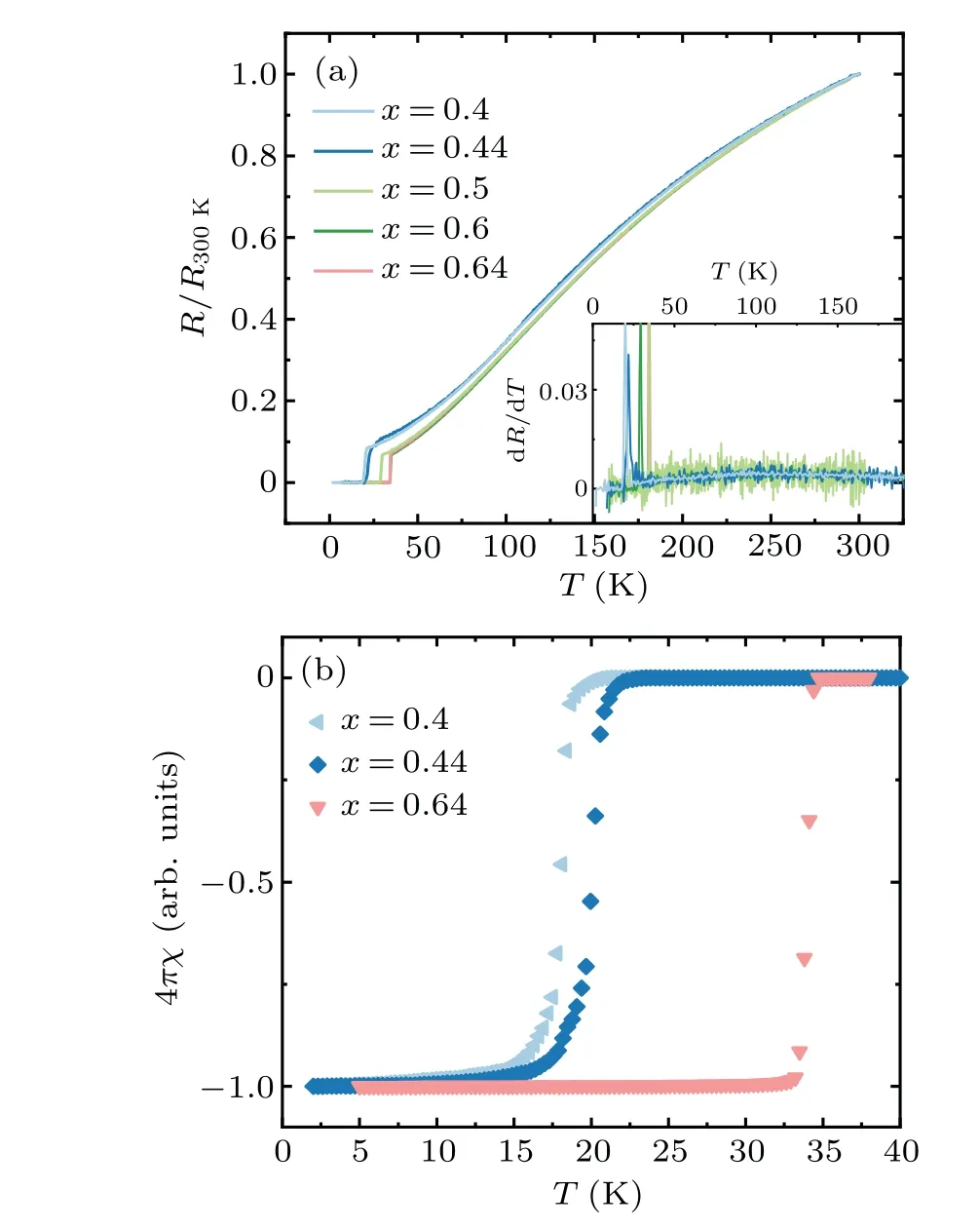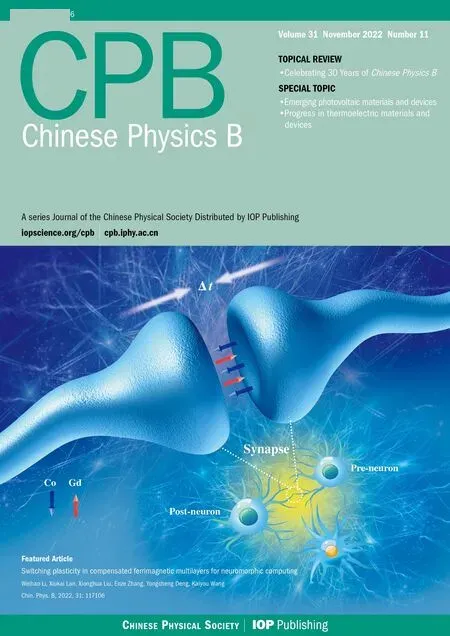Growth and characterization of superconducting Ca1-xNaxFe2As2 single crystals by NaAs-flux method
Hong-Lin Zhou(周宏霖) Yu-Hao Zhang(张与豪) Yang Li(李阳)
Shi-Liang Li(李世亮)1,2,4, Wen-Shan Hong(洪文山)1,2,5,‡, and Hui-Qian Luo(罗会仟)1,4,§
1Beijing National Laboratory for Condensed Matter Physics,Institute of Physics,Chinese Academy of Sciences,Beijing 100190,China
2University of Chinese Academy of Sciences,Beijing 100049,China
3School of Advanced Engineering,University of Science and Technology Beijing,Beijing 100083,China
4Songshan Lake Materials Laboratory,Dongguan 523808,China
5International Center for Quantum Materials,School of Physics,Peking University,Beijing 100871,China
High-quality superconducting Ca1-xNaxFe2As2 single crystals have been successfully grown by the NaAs-flux method, with sodium doping level x=0.4–0.64. The typical sizes of these crystals are more than 10 mm in ab-plane and ~0.1 mm along c-axis in thickness. X-ray diffraction,resistance and magnetization measurements are carried out to characterize the quality of these crystals. While no signature of magnetic phase transitions is detected in the normal state,bulk superconductivity is found for these samples, with a sharp transition at Tc ranging from 19.8 K (x=0.4) to 34.8 K(x=0.64). The doping dependences of the c-axis parameter and Tc are consistent with previous reports, suggesting a possible connection between the lattice parameters and superconductivity.
Keywords: iron-based superconductors,crystal growth,flux method
1. Introduction
Unconventional superconductivity emerges either from stoichiometric or doped cuprates, nickelates, pnictides, and chalcogenides,[1–6]or from pressure tuned heavy fermion compounds, Cr-based and Mn-based compounds.[7–12]It is a great challenge to reveal the microscopic mechanism of superconductivity in these materials due to various phases coexisting or competing with each other.[3,5]To achieve such a goal, high quality crystals are certainly essential for the exploration of those complex interactions among electrons and atoms.[12–22]For iron arsenide superconductors, the crystal growth methods are quite limited due to the highly toxic arsenic vapor.[23]Usually, the iron arsenide crystals are grown by flux methods in sealed quartz tubes, where the flux could be NaCl/KCl mixture, Sn, FeAs, NaF, CaAs, NaAs, KAs,etc.[24–53]At the early stage, the 1111-type iron-based superconductor (FeSC) LaFeAsO1-xFxwere grown by NaCl/KCl flux,[24–26]and the obtained crystals with several micrometer sizes are only suitable for transport measurements.[27,28]Later,the 122-type FeSCs are grown by Sn flux or FeAs self-flux methods,which significantly improve the sample sizes to centimeter scale but probably with some impurity phases.[29–35]Similar grown applications are successful in other systems such as 111-type, 112-type, and 1144-type FeSCs.[36–43]After that,the NaF,CaAs,NaAs,KAs fluxes with lower melting points are demonstrated to be very useful to grow the 1111-type FeSCs as well as other systems.[44–49]In particular, the hole-like 12422-type systems and the hoped-doped 122-type FeSCs grown by NaAs or KAs show very homogeneous quality and bulk superconductivity.[50–55]
The 122-type FeSCs are the most extensively studied systems due to available crystals with high quality and large sizes.[14–17]The parent compound of the‘122’families is typically in the form of AeFe2As2(Ae=alkaline earth metal,e.g., Ca, Sr, Ba), exhibiting both antiferromagnetic (AF) and structural phase transitions from 138 K to 203 K.[56–59]Superconductivity can be induced by hole (e.g., Na and K),electron (e.g., Ni, Co, Cu, Rh, Ir, Pd, La, Ce, and Pr),or isovalent (e.g., P and Ru) dopings on the alkaline earth metal, iron, and arsenic sites, respectively.[60–77]While the FeAs self-flux method can produce high quality crystals for those electron doped compounds throughout the phase diagram, homogeneous and tunable superconductivity in the hole doped compounds is still a challenge.[33–35,54,55]The 122-type FeSCs generally host a phase diagram with competing AF order and superconductivity similar to cuprates,but the details of the phase diagram strongly depend on the alkaline earth metal and the doped elements.[14,15]For example, in the electron doped systems such as Ba(Fe1-xNix)2As2or Ba(Fe1-xCox)2As2, the long-range stripe-type AF order in the orthorhombic lattice is gradually suppressed and degenerates to a short-range order finally disappearing aboveTcnear the optimal doping level.[78–81]The cases become more complicated in the hole doped systems, such as Ba1-xKxFe2As2,[82]Ba1-xNaxFe2As2,[83,84]Sr1-xNaxFe2As2,[85,86]and Ca1-xNaxFe2As2,[87]a tetragonal magnetic phase (so-calledC4phase) with ordered moments alongc-axis is revealed to competing with the orthorhombic magnetic phase (so-calledC2phase) just before the optimal doping level in the underdoped region, theC2phase may reentry at low temperature in Ba1-xKxFe2As2and Ca1-xNaxFe2As2.[82,87]Moreover,the superconducting dome for the same doped element is significantly distinct among Ba-, Sr-, and Ca-122 systems. Like say, the maximumTc= 30–35 K locates atx= 0.4, 0.55, and 0.75 for Ba1-xNaxFe2As2, Sr1-xNaxFe2As2, Ca1-xNaxFe2As2,respectively.[84–89]The Ca-122 compounds show a unique collapse tetragonal phase where both the AF fluctuations and superconductivity may be absent.[90–93]All these facts suggest that the chemical doping induced changes on the local crystalline structure are crucial to the electronic ground states in FeSCs besides the charge carrier concentration. Thus,further investigations on this issue are highly desired to understand the unconventional superconductivity in FeSCs, counting on high-quality and sizeable single crystals.
In this paper,we report a method to grow sizeable and homogenous Ca1-xNaxFe2As2single crystals with doping level fromx= 0.4 tox= 0.64. While AF order is absent in these batches of crystals, bulk superconductivity is found with transition temperatures ranging fromTc=20 K in thex=0.4 sample toTc=34.5 K in the optimally dopedx=0.64 sample. Compared to the FeAs self-flux method, this NaAs self-flux method is quite hard to reach the very underdoped level in Ca1-xNaxFe2As2. We summarize the results of Ca1-xNaxFe2As2in the literature and compare with the Ba1-xKxFe2As2system from underdoped region to optimal doping level. A linear dependence ofc-axis parameter and a parabolic dependence ofTcversus the doping levelxare found, respectively, suggesting a quantitative connection between the local crystalline structure and the unconventional superconductivity in FeSCs.
2. Experimental details
We used NaAs as flux to grow the Ca1-xNaxFe2As2single crystals. Firstly, three precursors NaAs, CaAs and Fe2As were prepared with highly pure raw materials Na(>99.5%),Ca(>99.9%), Fe(>99.5%) and As(>99.99%) by the solid state reaction method in evacuated and sealed quartz tubes.NaAs was synthesized by mixing many small pieces of Na and As powders and reacting at 400°C for 20 h. CaAs was prepared by mixing Ca grains and As powders and reacting at 400°C for 20 h then keeping at 630°C for another 20 h.Fe2As was synthesized by reacting the mixture of Fe and As powders at 500°C for 10 h then at 700°C for another 10 h. All heating process should be very carefully and gently under a rate less than 20°C/h,to avoid the danger from vapor of these raw materials. Secondly, these three precursors were mixed together at a molar ratio of CaAs:Fe2As:NaAs=(1-x):1:(x+3)to grow Ca1-xNaxFe2As2single crystals. After grinding for about 30 min, the mixture was loaded in an alumina crucible and then sealed under argon atmosphere in an Nb tube,this tube was further sealed in an evacuated quartz ampoule.Thirdly, the sealed mixture was placed in a box furnace and slowly heated up to 600°C and kept warm for 5 h to fully melt the NaAs flux, it was then heated to 980°C at a rate of 0.76°C/min, and to 1150°C at a rate of 0.425°C/min, hold for 24 h to melt the CaAs (melting point about 650°C) and Fe2As (melting point about 930°C) materials, followed by slowly cooling down to 650°C at a rate of 2°C/h to grow the crystals. Finally, the electricity of the furnace was turned off to cool down the mixture to room temperature naturally,until it is safe to fetch out. Large pieces of Ca1-xNaxFe2As2single crystals were obtained after crashing the tubes and cleaning the NaAs flux. Residual NaAs flux on the crystal surface can be fully dissolved in the deionized water.
The crystal surface morphology and distribution of elements were examined by a scanning electron microscope(SEM)equipped with energy dispersive x-ray(EDX)analyzer.The chemical compositions of our crystals were determined by the inductively coupled plasma (ICP) analysis. The crystalline quality and doping effects on the lattice parameters were checked by single-crystal x-ray diffraction (XRD) on a 9 kW high-resolution diffraction system (SmartLab) with CuKαradiation(λ=1.5406 ˚A)at room temperature in the reflection mode,with 2θranging from 10°to 65°. The Laue pattern was collected by an x-ray Laue camera(Photonic Sciences)in backscattering mode with incident beam alongc-axis. The resistivity was measured by the standard four-probe method in a physical property measurement system (Quantum Design-PPMS). The DC-magnetic susceptibility was measured with the zero-field-cooling (ZFC) method and a small fieldH=3 Oe in parallelc-axis in a magnetic property measurement system(Quantum Design-MPMS).
3. Results and discussion
We have successfully grown 5 batches of Ca1-xNaxFe2As2single crystals with nominal dopingx=0.3,0.4, 0.5, 0.6, 0.7. The actual doping concentrationx′is determined by the ICP method and listed in Table 1, where the relative errors are about 5% as estimated from the analyses on several pieces of crystals. Due to the excess NaAs precursor as the flux in the mixture, even a small nominalxcould result in significant actual dopings, givingx′=0.2+0.64x.Such effect hampers us to reach low doping level in the underdoped region in comparison to the FeAs-flux method.[33,94,95]For high doping levels, the Na concentration seems to reach a saturation point in this method. So far, overdoped Ca1-xNaxFe2As2crystals are still very hard to obtain, but overdoped Ba1-xKxFe2As2including KFe2As2can be grown by the KAs-flux method.[54,55,96,97]In the following, we use the actual doping level to refer to our samples.The homogeneity of our crystals is examined by SEM and EDX analyses,the results of three typical dopingsx=0.40, 0.44, and 0.64 are shown in Fig. 1. The SEM photos show flat surfaces with some crack edges from different layers. EDX analyses on four elements all exhibit homogenous distributions.

Fig.1. (a)–(c)SEM photos of the cleaved surfaces and element distribution analyses for Ca1-xNaxFe2As2 (x=0.40,0.44 and 0.64)crystals.(b)A typical EDX spectrum for one single crystal with x=0.64.

Fig. 2. (a) The x-ray diffraction patterns at room temperature for Ca1-xNaxFe2As2 single crystals. (b) A photo of Ca0.6Na0.4Fe2As2 platy monocrystal. (c)Typical Laue reflection at room temperature for our crystals.
The crystalline quality is checked by x-ray diffraction and presented in Fig. 2. Figure 2(a) shows the XRD patterns with the incident beam along thec-axis of our crystals. All diffraction peaks indexed as (0,0,l) (l=even) are sharp and no diffraction from impurity phases is observed.With the increase of Na doping, the 2θof the last peak shifts to low angle side, suggesting increasingc-axis lattice parameter. We have calculated thec-axis parameter by fitting the peak positions and listed in Table 1. The photo in Fig.2(b)shows the typical sizes of our Ca1-xNaxFe2As2single crystals. The dimensions of the largest crystal are about 17 mm×16 mm×0.5 mm. The cleaved surface is shiny under the light,and the texture is brittle. The Laue reflection inab-plane for Ca0.36Na0.64Fe2As2is shown in Fig.2(c). Again,the bright and sharp scattering spots indicate the high quality of this sample, clear orientations along [1,0,0] and [1,1,0] of the crystal can be easily identified.

Table 1. Doping concentrations, c-axis parameter, and Tc of ourCa1-xNaxFe2As2 single crystals.
Figure 3(a)shows the electrical resistance inab-plane under zero field as a function of temperature.We normalize them by the resistance at 300 K for comparison,all of them show a smooth evolution in the normal state and a sharp superconducting transition atTc. To search for the signature of any magnetic transitions, we plot the first-order derivative of the resistance versus temperature in the inset of Fig. 3(a). Only a narrow peak corresponding to the superconducting transition can be identified,the value ofTcfor each doping is listed in Table 1, too. Therefore, for all samples with actual doingx=0.40–0.64,they are paramagnetic in the normal state,which is consistent with the previous reports on polycrystalline samples.[82,87]We also notice that the residual resistance just aboveTcis less than 10%of the room temperature resistance, giving a large residual resistivity ratio RRR≈10.Such large RRR also confirms the high quality of our crystals. For references,RRR is about 5 for optimally hole-doped Ba1-xKxFe2As2,[33]and about 2 for optimally electron-doped Ba(Fe1-xNix)2As2.[34]For high pure KFe2As2grown by KAs flux, RRR can be over than 2000.[96,97]The superconducting volume of these Ca1-xNaxFe2As2crystals was measured by magnetization under a magnetic field of 3 Oe alongc-axis in ZFC mode. We only checked three typical samples withx=0.40, 0.44, and 0.64 as shown in Fig. 3(b). All of them show sharp superconducting transitions with a strong diamagnetic signal and a narrow width ΔT <2 K.The magnetic susceptibility 4πχ=-1 at low temperatures indicate the full Meissner state, namely bulk superconductivity in these samples. In the parent compound CaFe2As2,a magnetic transition with stripe-type order can be probed at aboutTN=170 K by the magnetization under high field,which shows a deletion belowTNand a linear temperature dependence aboveTN.[14,58]However, the normal state resistance is more sensitive to the magnetic/structural transitions in FeSCs,[33–36]thus we do not have to measure the magnetization up to high temperatures to further search the magnetic order.

Fig. 3. (a) The temperature dependence of resistance for Ca1-xNaxFe2As2 crystals. All data are normalized by the room temperature resistance. The inset shows the first-order derivative of the resistance.(b)Magnetization measured under ZFC mode for three typical dopings x=0.40,0.44,0.64.
Finally,we compare the doping dependence of thec-axis parameter and superconducting transitionTcwith the previous reports on Ca1-xNaxFe2As2.[75–77,87,89]As shown in Fig. 4,our results can merge well with previous reports for both parameters. In Fig. 4(a), we also plot the doping dependence of thec-axis parameter in Ba1-xKxFe2As2.[33,95]As we can see, for both hole doped systems, thec-axis lattice is continuously stretched by chemical substitutions, as the radius of alkali metal is larger than alkali earth metal.[98,99]Thecaxis has a linear relationship with doping levelxin the underdoped regime:c=0.78x+11.7 for Ca1-xNaxFe2As2andc= 0.88x+12.98 for Ba1-xKxFe2As2,[95,98,99]with similar slopes. With thoseTcof Ca1-xNaxFe2As2summarized in Fig. 4(b),[75–77,87,89]we can roughly fit by a parabolic function:Tc=-155.2x2+227.18x-48.89. Such a relation probably suggests that the superconducting behavior in the underdoped region is also strongly related to thed-spacing between Fe-As layers. Particularly, for those systems with smallerc-axis parameters thus closer distance of the adjacent Fe–As layers, the inter Fe–As layer coupling is stronger, thus to reach the optimal superconductivity upon doping requires higher concentration. This naturally explains the increasing doping to the optimal level in (Ba,Sr,Ca)1-xNaxFe2As2systems, where their parent compounds (Ba,Sr,Ca)Fe2As2have decreasingc-axis:c=13.04,12.37,11.75 ˚A at room temperature, respectively.[84–89]For the overdoped region, although thec-axis continuously increasing upon doping, strong mismatches of the Fermi surface sizes are expected to suppress the superconducting pairing.[5]It was proposed in Ref.[100]thatTcis higher when the pnictogen height and As–Fe–As bond angle more close to form a regular tetrahedron among many systems of FeSCs. This could be a consequence from competing interactions strongly associated with the local crystalline structure.

Fig. 4. (a) Doping dependence of the c-axis parameters in the Ca1-xNaxFe2As2 system[75–77,87,89] in comparison with the Ba1-xKxFe2As2 system.[33,95,98,99] Here the relative errors for the chemical compositions of our sample are about 5% from the ICP measurements, errors for other samples are obtained from the above-mentioned literature, and the solid lines are linear fittings. (b) Summary of the doping dependence of Tc in Ca1-xNaxFe2As2.[75–77,87,89] The solid line is a parabolic fitting to all data.
4. Summary
In summary,we have successfully grown a series of large Ca1-xNaxFe2As2single crystals with actual Na dopingx=0.4–0.64 using the NaAs-flux method. These crystals show bulk superconductivity but no magnetic transitions. The positive doping dependences both forTcandc-axis lattice parameter suggest that they are probably related.These homogeneous and sizable crystals provide us chances to further investigate the unconventional superconductivity in FeSCs,especially for those techniques requiring large crystals,such as inelastic neutron scattering and μSR.
Acknowledgements
The authors thank Professor Xing-Ye Lu, Dr. Zhen Tao,Dr. Li-Hong Yang, Dr. Jie Li and Mr. Wei-Wen Huang for assistance in sample characterization.
Project supported by the National Key Research and Development Program of China(Grant No.2018YFA0704200),the National Natural Science Foundation of China (Grant Nos.11822411 and 11961160699), the Strategic Priority Research Program (B) of the CAS (Grants Nos. XDB25000000 and XDB33000000), the K. C. Wong Education Foundation(Grant No. GJTD-2020-01), the Youth Innovation Promotion Association of CAS (Grant No. Y202001), the Postdoctoral Innovative Talent program (Grant No. BX2021018),and the China Postdoctoral Science Foundation (Grant No.2021M700250).
- Chinese Physics B的其它文章
- A design of resonant cavity with an improved coupling-adjusting mechanism for the W-band EPR spectrometer
- Photoreflectance system based on vacuum ultraviolet laser at 177.3 nm
- Topological photonic states in gyromagnetic photonic crystals:Physics,properties,and applications
- Structure of continuous matrix product operator for transverse field Ising model: An analytic and numerical study
- Riemann–Hilbert approach and N double-pole solutions for a nonlinear Schr¨odinger-type equation
- Diffusion dynamics in branched spherical structure

